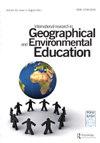数字和图形——在不确定的时代,我们需要什么样的数学素养来进行地理教育
IF 3.1
Q2 EDUCATION & EDUCATIONAL RESEARCH
International Research in Geographical and Environmental Education
Pub Date : 2022-01-02
DOI:10.1080/10382046.2022.2018756
引用次数: 2
摘要
当我们在地理教育中提到数学思维时,人们自然会想到计算代表性分数或确定人口的总生育率。虽然数学思维考虑了学生在解决问题时可以使用的启发式策略(Stacey,2006),但这些策略需要运用算术、图形和数学素养领域的技能和知识。新冠肺炎大流行突出表明,公民需要基本的数学知识来应对疾病及其影响日益复杂的空间性。在这篇文章中,我们将把讨论范围扩大到主要关注数学素养。自2020年初新冠肺炎疫情爆发以来,从世界卫生组织到地方政府和媒体,数字信息和数学表示一直在传播,以使公民了解该疾病。公民需要能够批判性地考虑政治言论,以确保他们了解感染的全球传播、保持社交距离的必要性和疫苗接种的必要性。然而,有一种假设是,人们可以很好地解释所有的信息和数学表示。出现在我们的电视屏幕和社交媒体上的术语包括数学模型、感染率、传播、倍增时间和繁殖数(R值)。这些数字是什么意思?更糟糕的是,报告中还有许多图表伴随着这些数字。希望在这些情况下,所使用的术语都有明确的定义,但如果没有呢?如果公民在提供定义时没有注意到媒体的报道,该怎么办?疫情媒体报道的一个关键组成部分是视觉图像——图形和唤起同情的照片,提供了疾病和哀悼的人性面貌。我们可能不会立即将数学素养和地理之间的关系视为人类如何相互作用、环境和社会。我们如何利用这些信息肯定会对地理教育产生影响。事实上,Chang和Kidman(2021)认为,规模等概念对于理解“地方”和“景观”以及生活在一个“紧密相连的世界”意味着什么至关重要(国际地理联盟地理教育委员会,本文章由计算机程序翻译,如有差异,请以英文原文为准。
Numbers and graphs - what sort of mathematical literacy do we need for geographical education in uncertain times
When we mention mathematical thinking in geographical education, people naturally think about calculating representative fractions or determining the total fertility rate of a population. While mathematical thinking considers the heuristic strategies that the student can use in solving problems (Stacey, 2006), these strategies require skills and knowledge that draw on domains of numeracy, graphicacy and mathematical literacy. The COVID-19 pandemic has highlighted a state where citizens need basic mathematical literacy to navigate the increasing complexities of spatiality of the disease and its impact. For this article, we shall scope the discussion to primarily focus on mathematical literacy. From the World Health Organisation to local governments and the media, numerical information and mathematical representations have been circulated to keep citizens informed about the COVID-19 disease since the onset of the pandemic in early 2020. Citizenry needs to be able to critically consider political rhetoric to ensure that they understand the global spread of infection, the need for social distancing and the vaccination imperative. However, there is the assumption that people can interpret all the information and mathematical representations well. Terms that appear on our television screens and social media include mathematical modelling, infection rates, spread, doubling time, and reproduction number (the R-value). What do these numbers mean? To make matters worse, there are also numerous graphs that accompany these numbers in the reports. Hopefully, the terms used were clearly defined in these instances, but what if they were not? What if citizens were not paying attention to the media reports when the definitions were provided? A critical component of the pandemic media coverage is the visual imagery – the graphs and empathy invoking photographs that provide the human face of illness and mourning. We may not immediately think of the relationship between mathematical literacy and geography as how humans interact with each other, the environment and society. How we engage the information will certainly have implications for geographical education. Indeed, Chang and Kidman (2021) have argued that concepts like scale are crucial to understanding “places” and “landscapes” and what it means to live in a “tightly interconnected world” (International Geographical Union Commission on Geographical Education,
求助全文
通过发布文献求助,成功后即可免费获取论文全文。
去求助
来源期刊

International Research in Geographical and Environmental Education
EDUCATION & EDUCATIONAL RESEARCH-
CiteScore
5.20
自引率
33.30%
发文量
11
期刊介绍:
International Research in Geographical & Environmental Education publishes quality research studies within the context of geographical and environmental education. The journal endeavours to promote international interest and dissemination of research in the field, provides a forum for critique, and demonstrates the relevance of research studies to good professional practice.
 求助内容:
求助内容: 应助结果提醒方式:
应助结果提醒方式:


